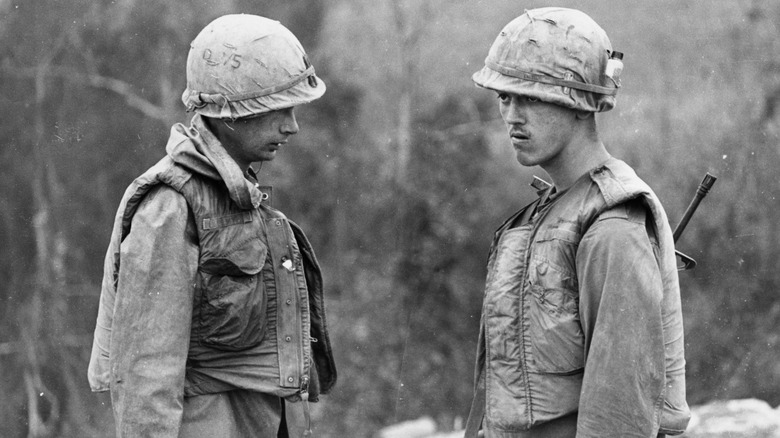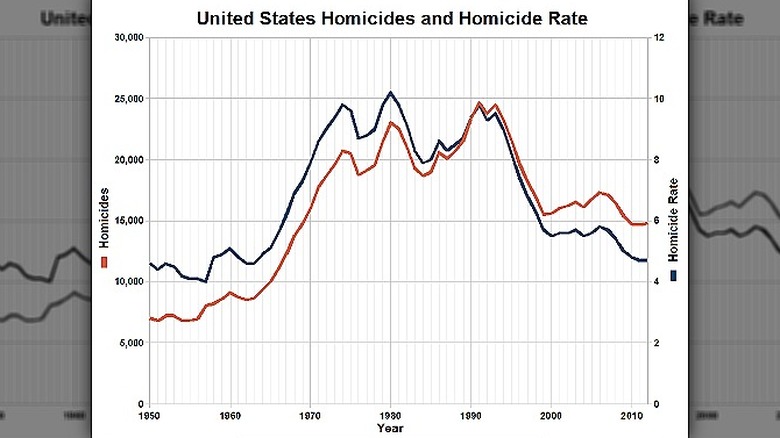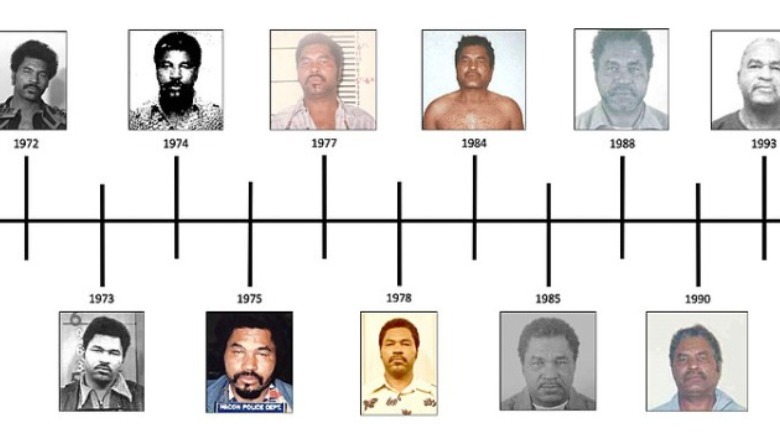Is This Why There Were So Many Serial Killers From 1970 To 2000?
In Slate, crime historian Harold Schechter refers to the 1970s and 1980s as the "golden age of serial murder." It was the era when the Zodiac Killer, the Hillside Strangler, Jeffrey Dahmer, and others leered at us from within their photos on the evening news, omnipresent in the legacy of terror they caused. Per data compiled by Dr. Mike Aamodt of Radford University (reported by Discover Magazine), statistics seem to indicate that an estimated 770 serial killers were active in the 1980s, compared to roughly 30 in 2015 (according to Discover).
Out of all the serial killers we've documented in the United States, nearly 80% of them were active between the years 1970 and 1999, according to estimations by Peter Vronsky, author of "American Serial Killers: The Epidemic Years," per Rolling Stone. Although serial killers have probably always existed, with television, new technology, postwar trauma, improved data collection, and a rise in public investigations, the archetypal serial killer captured the darker side of public imagination from 1970 to 1999 when "serial" homicides underwent a drastic spike. But why?
Theory: Postwar Trauma Disturbed A Generation
Vronsky told Rolling Stone that to understand the reasons for the rise and fall of serial killers, you have to take in various factors. "The reason behind this is manyfold," he said, "encompassing everything from sociological changes, to biology, to technology, to linguistics."
According to Vronsky, the postwar climate of the 1970s and vast numbers of American soldiers returning to their families may have drastically altered the childhood environments of a generation of kids. Being raised by PTSD-stricken fathers (prior to the existence of PTSD as a medical diagnosis) could have, in his opinion, led to an uptick of volatility, violence, and instability within the childhood home, triggering latent violent tendencies in young children who may have later grown up to act on them.
James Fallon, author of "The Psychopath Inside" (and a self-diagnosed psychopath himself), expressed his agreement with Vronsky telling Rolling Stone, "In cases like, for example, the BTK killer [Dennis Rader], Richard Cottingham [the Torso Killer], their fathers were returning war veterans with PTSD ..." But Fallon also pointed out that lots of children grew up with war vets for dads and did not become serial killers, so he thinks it's a combination of environment and something in they may have been pre-disposed to due to their genes.
Theory: Improved Data Collection Techniques Allowed Us to Identify Patterns in Crime
After 1970, new technology made it easier to link crimes and identify serial perpetrators, and with the rise of television, people were constantly reminded serial murderers were lurking. As the BBC reported, in the 1970s, police also began opening investigations of a more advanced nature and pursuing them for more prolonged periods of time, which may have contributed to the perceived intensity of the decades-long spike.
According to Discover Magazine and ABA Journal, data collection also drastically improved in this era, allowing researchers and investigators to track crime trends, identify potentially-related incidents, and establish patterns that may indicate evidence of a serial perpetrator. Another reason the 1970s and '80s seem particularly wracked by serial killers could be the dawn of mass media and the rise of television, which, according to Salon, some argue may have increased their visibility and thereby the atmosphere of cultural hysteria.
We don't know the exact significance of each of these factors, but it's clear that there was a significant spike in documented serial murder during the 20th century's later decades — data from Radford University illustrates an uncontested surge from 1970 to 1999. The subsequent decline after the year 2000 is harder to explain.
Theory: Since Police Homicide Clearance Rates Have Drastically Declined, Serial Killers Post-2000 Aren't Getting Caught
The decline in documented serial murders could have a relatively simple explanation: we are finding fewer serial killers because fewer killers are getting caught. While data from Radford University (republished by Discover Magazine) indicates a sharp decline in the total number of known serial killers, we've also seen a sharp decline in murder clearance rates – FBI speak for solving a case.
According to FBI data compiled by The Marshall Project, the average homicide clearance rate in 2020 was hovering around 50% — meaning not even close to the majority of murders reported are solved. For context, some departments had clearance rates as high as 91% in 1965, according to reporting by NPR and The Atlantic, and roughly 70% in 1980, according to The Marshall Project.
Thomas Hargrove of the Murder Accountability Project believes these unsolved murders may be the work of serial killers that aren't getting caught. According to Discover Magazine, the United States currently has one of the lowest homicide clearance rates in the Western world — a dramatic decline over the decades, which begs the question, are there fewer serial killers? Or are they just not getting caught?



